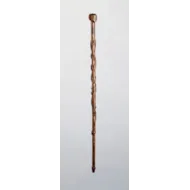A Rare Native American Eastern Woodlands Carved Wood Staff
A Rare Native American Eastern Woodlands Carved Wood Staff
The shaft carved with a snake around which a family of nine beavers run and one long tailed bird sits, their eyes studded with brass tacks. The base carved with a row of four deer heads and slightly above, a row of three human effigy heads, all of the eyes studded with brass tacks. The shaft also etched in black with a hunting scene consisting of dogs, pine trees, men with guns, one man with a net, and snakes twining to the top of the staff where a larger man with a hat and pipe is depicted in profile. The handle with a double janus effigy head of an Indian with brass eyes and the top of the head with a silver plaque initialled ‘JW’.
Circa 1850 – 60
Size : 77.5 cm long – 30½ ins long
The shaft carved with a snake around which a family of nine beavers run and one long tailed bird sits, their eyes studded with brass tacks. The base carved with a row of four deer heads and slightly above, a row of three human effigy heads, all of the eyes studded with brass tacks. The shaft also etched in black with a hunting scene consisting of dogs, pine trees, men with guns, one man with a net, and snakes twining to the top of the staff where a larger man with a hat and pipe is depicted in profile. The handle with a double janus effigy head of an Indian with brass eyes and the top of the head with a silver plaque initialled ‘JW’.
Circa 1850 – 60
Size : 77.5 cm long – 30½ ins long
The double head on this stick is most probably representing a guardian spirit, and the carving of these effigies commonly representing spiritual beings was an ancient and widespread expression of Woodland Indian art. This staff also has an etched hunting scene and the visual language of pictographic images conveyed powerful messages for those with the ability to read them. The engraved drawn images did not originally constitute a formal written language but served as an aid to memory and helped the owner gain the spiritual and earthly attributes of the human and animal images depicted. Later these images became designed to meet the expectation of the Euro-American trade and the designs on this staff bear a striking resemblance to those found on early 19th century birch bark artefacts. One of the earliest known birch-bark souvenirs is a hunting knife sheath collected in 1783 by J Ludwig Unger, a Brunswick mercenary who fought in the American Revolution. It has depictions in dyed moose hair of a man with a gun and dog, with two long tailed birds amongst pine trees.
A Rare Native American Eastern Woodlands Carved Wood Staff

SOLD
